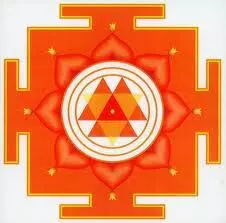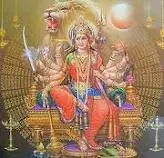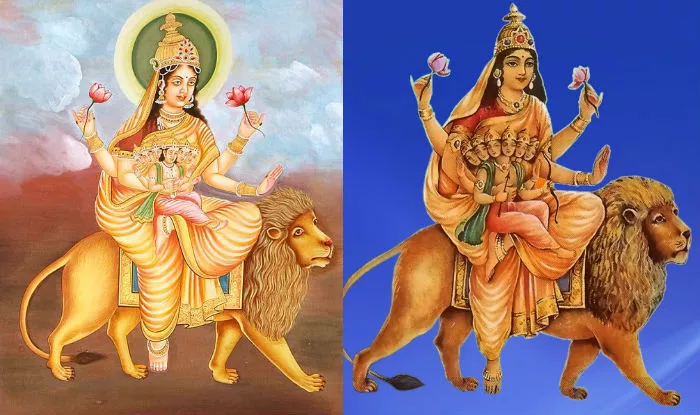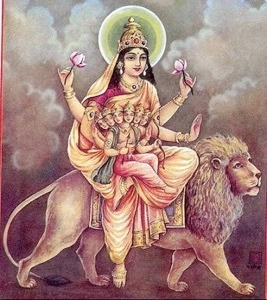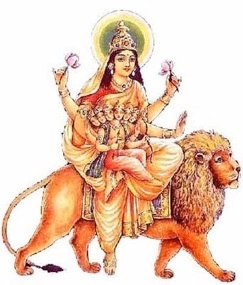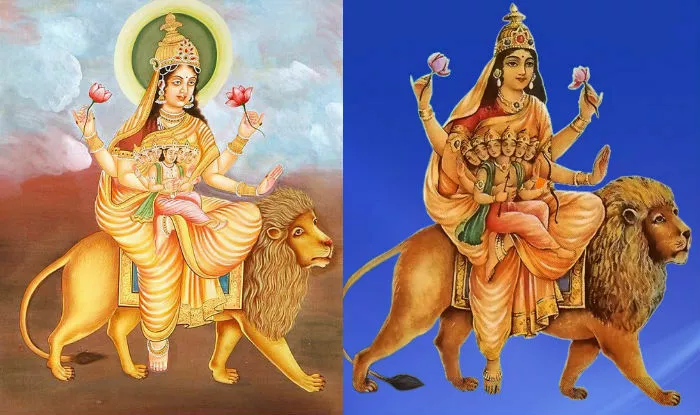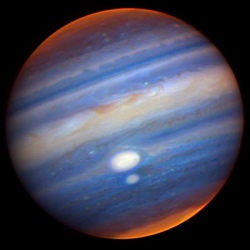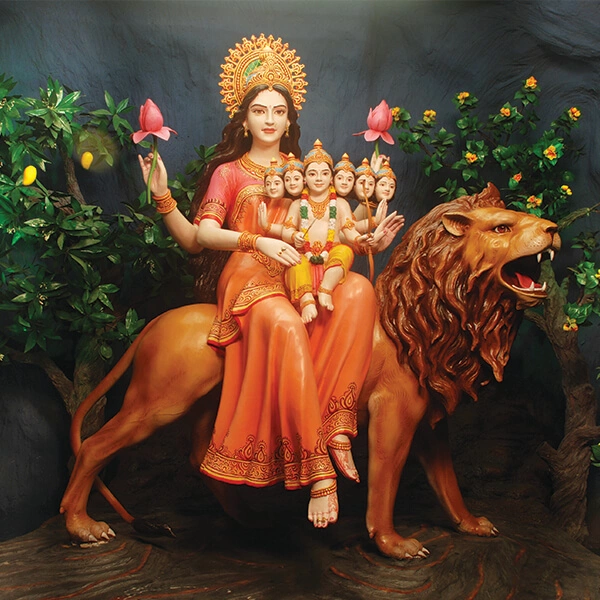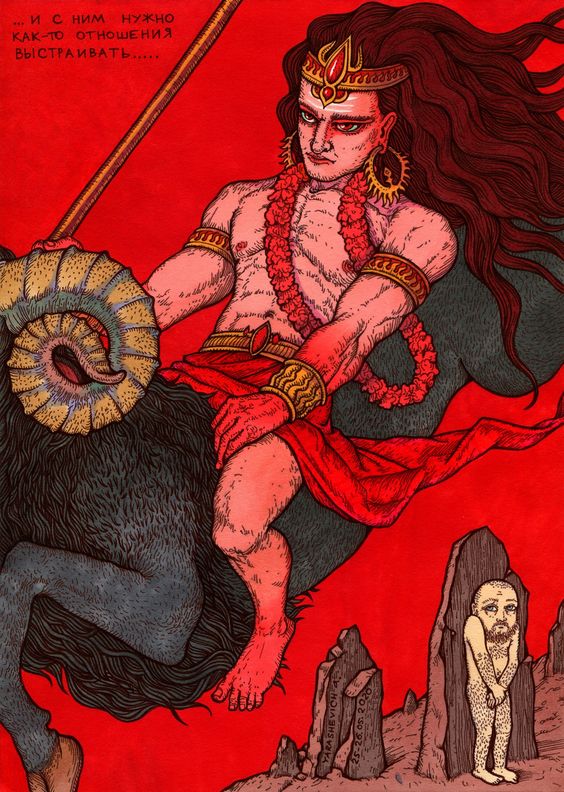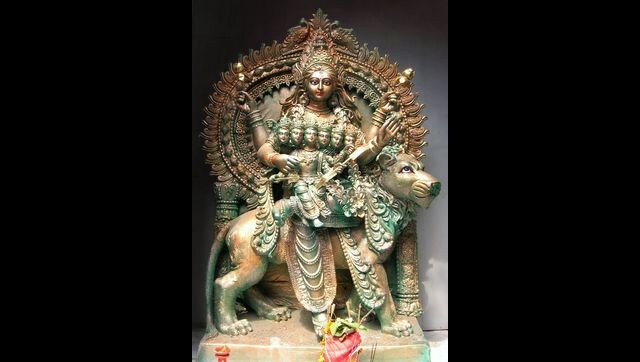#Happy #Navratri Day 5
Panchami
#Maa #Skandamata Puja
26th
March 2023
(Sunday)
Navratri Day 5: #Yellow
The colour of Day 5 is yellow. The colour stands for happiness and brightness. On this day #Goddess Skandmata is worshipped and is also known as the mother of Lord Kartikey or Skanda.
Maa Skandmata has four arms and she rides on a lion. 2 of her arms carry lotus, 1 arm carry baby #Kartikeya, and another one stays in the Abhaya Mudra. As she sits on the lotus, Goddess Padmasana is her another name. She is the Goddess who can bless her devotees with power and prosperity. Also, she can bless her worshipper with immense intelligence as well as salvation. She is also considered as the Goddess of fire. As she is the epitome of motherly love in this form, devotees get blessed with her immense love.
Legend
As the legend goes, there was a great demon, Tarkasur. He did extreme penance for years to impress Lord Brahma; and finally the Lord appeared in front of him. He, then, requested for a boon of becoming immortal. Brahma Ji explained that death is inescapable on this planet earth. Being quite witty, he thought that Shiva will never get married, as he is an ascetic. So, he requested Brahma to grant him a boon that he can only be killed by the son of Shiva. Lord Brahma agreed on this and he started torturing the world thinking that he cannot be killed.
Being tortured, all the Devtas visited Lord Shiva and requested to him to get married. Hence, he married Goddess Parvati and became the father of Lord Kathikeya (Skand Kumar). When Kartikeya grew up, he killed the Demon Tarkasur and saved everyone.
Astrological Aspect
Planet Mercury (Budh) is ruled by Goddess Skandmata. Worshipping her kills the ill effects of Mercury.
Mantras
ॐ देवी स्कन्दमातायै नमः॥
Prarthana Mantra:
सिंहासनगता नित्यं पद्माञ्चित करद्वया।
शुभदास्तु सदा देवी स्कन्दमाता यशस्विनी॥
Stuti:
या देवी सर्वभूतेषु माँ स्कन्दमाता रूपेण संस्थिता।
नमस्तस्यै नमस्तस्यै नमस्तस्यै नमो नमः॥
Dhyana Mantra:
वन्दे वाञ्छित कामार्थे चन्द्रार्धकृतशेखराम्।
सिंहरूढ़ा चतुर्भुजा स्कन्दमाता यशस्विनीम्॥
धवलवर्णा विशुध्द चक्रस्थितों पञ्चम दुर्गा त्रिनेत्राम्।
अभय पद्म युग्म करां दक्षिण उरू पुत्रधराम् भजेम्॥
पटाम्बर परिधानां मृदुहास्या नानालङ्कार भूषिताम्।
मञ्जीर, हार, केयूर, किङ्किणि, रत्नकुण्डल धारिणीम्॥
प्रफुल्ल वन्दना पल्लवाधरां कान्त कपोलाम् पीन पयोधराम्।
कमनीयां लावण्यां चारू त्रिवली नितम्बनीम्॥
Stotra:
नमामि स्कन्दमाता स्कन्दधारिणीम्।
समग्रतत्वसागरम् पारपारगहराम्॥
शिवाप्रभा समुज्वलां स्फुच्छशागशेखराम्।
ललाटरत्नभास्करां जगत्प्रदीप्ति भास्कराम्॥
महेन्द्रकश्यपार्चितां सनत्कुमार संस्तुताम्।
सुरासुरेन्द्रवन्दिता यथार्थनिर्मलाद्भुताम्॥
अतर्क्यरोचिरूविजां विकार दोषवर्जिताम्।
मुमुक्षुभिर्विचिन्तितां विशेषतत्वमुचिताम्॥
नानालङ्कार भूषिताम् मृगेन्द्रवाहनाग्रजाम्।
सुशुध्दतत्वतोषणां त्रिवेदमार भूषणाम्॥
सुधार्मिकौपकारिणी सुरेन्द्र वैरिघातिनीम्।
शुभां पुष्पमालिनीं सुवर्णकल्पशाखिनीम्
तमोऽन्धकारयामिनीं शिवस्वभावकामिनीम्।
सहस्रसूर्यराजिकां धनज्जयोग्रकारिकाम्॥
सुशुध्द काल कन्दला सुभृडवृन्दमज्जुलाम्।
प्रजायिनी प्रजावति नमामि मातरम् सतीम्॥
स्वकर्मकारणे गतिं हरिप्रयाच पार्वतीम्।
अनन्तशक्ति कान्तिदां यशोअर्थभुक्तिमुक्तिदाम्॥
पुनः पुनर्जगद्धितां नमाम्यहम् सुरार्चिताम्।
जयेश्वरि त्रिलोचने प्रसीद देवी पाहिमाम्॥
Kavacha Mantra:
ऐं बीजालिंका देवी पदयुग्मधरापरा।
हृदयम् पातु सा देवी कार्तिकेययुता॥
श्री ह्रीं हुं ऐं देवी पर्वस्या पातु सर्वदा।
सर्वाङ्ग में सदा पातु स्कन्दमाता पुत्रप्रदा॥
वाणवाणामृते हुं फट् बीज समन्विता।
उत्तरस्या तथाग्ने च वारुणे नैॠतेअवतु॥
इन्द्राणी भैरवी चैवासिताङ्गी च संहारिणी।
सर्वदा पातु मां देवी चान्यान्यासु हि दिक्षु वै॥
With this, we hope that you will make the best of Navratri’s fifth day. May Skandmata Durga blesses you with all the goodness of life.
Happy Navratri!
Now as one might presume – She is the Mother (Mata) of Lord Skanda, one of our … many War Gods. Takes after His Mother in that regard!
The story of Skanda’s conception and birth is perhaps a bit of a curious one – as it is not, in fact. Devi Herself Who gives birth to the young prince (Kumara – another epithetic theonym of He).
Instead, He comes to us from the Krttika cluster (hence His Six Heads – One for each Mother) – better known to us here in the West as the Pleiades. Something which I believe to resonate with the circumstances for the conception of Heimdallr in the Nordic sphere.
But let us take things back a few steps.
As we have said, the Story of the NavRatri cycle is one of Reunification – of the Divine Couple re-finding Each Other after having become separated in circumstances both tragic and lamented … yet arguably necessary in order to bring certain events to their logical progression.
One result of this was the Death of Devi as Sati. The other was another sort of ‘death’ – in the figurative sense, at least. As Lord Shiva had chosen to withdraw Himself from the World to head up into the High Himalayas in order to meditate, smoke weed, and attempt to overcome His immense, unbearable grief at losing His Other Half. I am sure various of us can relate.
However, simply because we are no longer (we think) moving, does not mean that the Universe has given up upon moving around us. The world turns – and though we know it not – we turn with it.
And so it was that the latest in a long, long line of demonic foes came to rise.
This demon warlord was named Taraka, or Tarakasur – an interesting ‘ironic resonancy’ with Lord Skanda (otherwise known as Kartikeya – ‘Of the Krittikas’), given Taraka also means ‘Star’ (or, at least, celestial light – the corona of a comet, for instance, in some more specialized contexts).
Now, there is a standard pattern to these sorts of myths. Some demon gains prominency and sets his mind upon casting down the Gods. He realizes that he, himself, shall be unable to meaningfully go up against the Heavens as he is, and so undertakes immense austere penances and propitiation in order to win a Boon from a certain favourably-disposed force … customarily asking for Immortality / Invincibility.
This is logical. If one is going to go and fight the Gods Themselves, then one had best be – in a word – unkillable.
It is also impossible.
The way that our relevant legalistic metaphysics works – they are only able to be accorded a ‘conditional’ invulnerability. They have to have some weak-point – some condition to which they remain vulnerable.
The weakness that the demon chooses is often an interesting insight into their character – Mahishasur, for instance, was a misogynist and contemptuous of the fairer sex … and so, he chose as his ‘condition’ that he could only be taken down by a woman, precisely because he believed that no woman could possibly be a threat to him. Which, of course, was a spectacularly stupid thing to do given that Devi (Whom we shall be meeting in the next Night of NavRatri as Katyayani) … has a bit of a reputation in these areas – as the foremost of our War Gods.
But nobody ever said that the arrogance of demons was commensurate with their sagacity – most of the time, anyway.
Durgamasur was smart enough to request an entirely different boon – that of wiping the knowledge of the Vedas from the minds of mankind, thus leading to a weakening of the Gods through the cessation of the performance of the Vedic rites of sacrifice that nourish and strengthen Them. But more upon him some other time.
Tarakasur, however, chose a rather more straightforward vulnerability. He was acquainted with the events surrounding Lord Shiva’s immense sadness and why He had retreated from the world – the loss of His Beloved Wife. He knew just how …. inconsolable Lord Shiva was upon this matter – how absolutely devoted to His Wife He had been (and yet still remained, even in Her Death). And therefore, he surmised, how immensely unlikely He was to ever remarry. For how could He, when He still carried only Her within His Deepest Heart?
Tarakasura thusly chose as his condition – that he would only be able to be vanquished by a yet-to-be-born Son of Shiva. Reasoning, perhaps rather logically, that it was almost certain that Lord Shiva – in the absence of His now-deceased Wife – would never conceive another Son; and thus rendering him functionally invincible pending this apparently inconceivable circumstance.
To twist the common saying, though – ‘Demons Plan, Fate Laughs’.
Knowing of this prophecy, certain Divinity attempts to do something about the situation. Kamadeva, the God of Love, is sent to endeavour to get Lord Shiva to ‘move on’ … which results in Shiva burning Kama to ashes when He detects the intrusion into His Mighty Mind, and as a perhaps rather natural outpouring of the renewed sense of grief which He experiences when a pleasing romantic memory of His Wife is revealed to have been .. just exactly that – a memory, once more.
However, as we have covered in previous NavRatri pieces, this is not the end of the tale. Rather, His dead Wife has reincarnated (Shailaputri) – and not all that far away from His present situated circumstance. She is seeking Him (Brahmacharini). They Reunify, Remarry (Chandraghanta), and are indeed in a position to bring forth another Child (Kushmanda, in a sense).
At this point, Agni moves to safeguard the future by ‘stealing’ the embryo of Skanda from Parvati’s womb – His reasoning being that before the God is born, should Tarakasur become aware of Shiva having successfully conceived a Son, both Mother and (pre-natal) Child should prove at grave risk from the demon.
This, however, is not explained to Parvati – and when She finds out what had occurred, She curses Agni (Flame) to be indiscriminately all-devouring, always wreathed by black smoke, and to ever have His food be riven with impurities.
The yet-to-be-born Skanda is spirited away, and in order to further safeguard Him, is borne to term by not one but six Mothers – the Krttika (Pleiades) Star-Maidens. As we have said, this circumstance should appear to resonate with the birth of Heimdallr to His Nine Mothers found in the waters at the edge of the world (a point arguably in common with the Stars in the archaic Indo-European view; and we should further note a rather prominent 7 => 9 shift between Vedic and Eddic traditions, as well as the curious situation wherein the Pleiades constellational cluster, at latitudes further from the equator, appears to have nine rather than six (or, for that matter, seven) stars to it).
Yet it also resonates in a curious way with the more archaic Hindu layers of mythology – wherein we find Agni in romantic relationship with Svaha … Who has taken the form of Six of the Seven Pleiades, and, yes, leading to a situation involving the conception of Kumara – that instead features Kumara being born to the Krttikas.
The situation is rendered rather more clarified when one considers the voluminous and repeated attestations in the Vedas for Lord Shiva and Agni being the same deific. And, further, the attestation in the Puranic literature for Svaha as the Wife of Rudra – also known as Vikeshi, which we mention due to the circumstance of Vikesi in the conception (again via a certain ‘displacement’ of seed) of Mangala … that is to say, Mars.
To quote from a relatively recent earlier work of mine ( https://aryaakasha.com/2022/01/04/tuesday-the-day-of-mangala-mars/ ):
“The Puranic mythology around Mars makes for interesting reading. There, we find the origin of Mangala stated to be drops of sweat from tapasic exertion from the brow of Lord Shiva that had fallen upon the Earth (with the Latter acting as His Mother for these purposes).
Shiva’s situation at the time of this was engaging Himself in strenuous pursuits to endeavour to control and contain His immense grief at losing His Wife, Lady Sati.”
That is the presentation contained within the Skanda Purana at IV 1 17 4-6; and also the Shiva Purana at II Rudra Samhita 3 10 7-27.
Although another Puranic narrative presents the circumstances somewhat differently. In Brahmanda Purana II 10 78 we find Sharva (‘The Archer’ – Rudra) married to Vikeshi as Her Husband (with pointed ‘Earth’ linkage), and states Angaraka (Mars) to be Their Son; whilst Brahmanda Purana, II 24 48 directly equates Skanda with Mars / Mangala (there referred to as Angaraka) and in line 91 states Kumara Mars born to Vikesi and Agni. The matrimonial situation is further buttressed by Markandeya Purana 52 – wherein Rudra in His Ishana form is stated to be married to Vikesi (Isana being ‘Light’, ‘Ruler’; and in the Shatapatha Brahmana (VI 1 3 17) being that Form and Name of Rudra-Agni (therein Himself referred to as Kumara – ‘Young Prince’) correlate with the Sun), with Their Son being Lohitanga (Mars, again); whilst elsewhere in the same section we find Rudra’s Bhima form to be married to Svaha with Their Child being Skanda. As we can clearly see, it is a situation of many Names, many Qualities, many Aspects, many Facings even – for but Three.
As the Markandeya Purana then puts it:
“Such was Rudra Himself. He found Satī for his wife; and through Dakṣa’s curse Satī quitted Her body. She was the Daughter of Himavat by Menā, O brāhman; Her brother was Maināka, the chiefest friend of Ambhodhi (the Ocean.) And the Lord Bhava [Rudra] married Her again as His Only Wife.”
(F. Eden Pargiter translation)
We might also ponder the situation of the Krittikas Themselves – wherein They go from numbering Seven in the archaic Vedic Age, through to Six by the time of the Puranas. This is not something unique to the Hindusphere – as it also prominently occurs amongst the Greeks. In both cases, mythic explanations present the reasoning for one of the Seven Sisters having become dimmed – or even outright leaving the Heavens.
We have considered some of the Vaidika star-lore pertaining to the Krttikas in our earlier work explicating the #Krittika ‘Six Swords of the Stars’ bindrune row that I had created for somebody –
https://aryaakasha.com/2021/12/02/krttika-the-six-swords-of-the-stars/
One point that I would quote from the above that is pointedly relevant for current circumstances is the following:
“In a sense, I suppose we may think of the Krittikas as being ‘Fire-Blades’ [the name itself renders as ‘Cutters’]. They connote both ‘destruction’ and ‘illumination’ (which we can also phrase as ‘Purification’ – ‘Hallowing’) – and, most especially, both at once. The one via necessity precedes the other. Aptly for this purpose, They are presided over by Lord Agni as the Deific – a situation which also resonates with the mythological presentation, as we have covered in some detail elsewhere (and fully intend to revisit more in the future). We have also undertaken to represent an additional element to the Indo-European mythology around the constellation via the fact that there are Six Runes here – for Six Sisters, Six Star-Maids.
In both Hellenic and Hindu reckoning there were archaically Seven of These – with one, Amba (to use the Vedic), having mysteriously dimmed and disappeared. However, particularly given the overt resemblance of ‘Amba’ to … a certain figure of this name … I have my enduring belief as to where (and, most especially, Who) it is that She eventually Returns To.”
You see how this immediately resonates with the circumstances of NavRatri – as well as other, more personal points of promontory.
Elsewhere in that (A)Article we had also explored the theme presented in the Vedas for the Krttikas in connexion with Invocation, Prayerful Hymns, Ritual – and we should surmise that there is indeed an eminently logical point of contextualization here for why They are Chosen to bear Lord Skanda into this world. A Holy Warrior, indeed, thusly congealed through the Rites (Agni included as the central element) and the Prayer-Songs – likely under the correct and auspicious Constellation, just as was the Flaming Sword of Rudra as attested in the Mahabharata.
In terms of nomenclature, we should also draw attention to the meaning of Skanda – a term which (to quote myself from some years ago) “connotes charging, attacking, and leaping or springing forth “; and which is often connected to the curious circumstances of Skanda’s conception and birth. However, we instead prefer another interpretation – one which connects this theonymic and its purport instead to “Lord Skanda’s role and function – as the great warrior. Further, the likely PIE roots of the name, often proposed as “Skend” (‘Jump’), but to which I would also speculatively add “Skewd” (“shoot” or “throw”, and the same root as “Skewer” in modern English – a rather important thing for a soldier, equipped with a spear – or, as with many depictions of Skanda seated in the lap of SkandaMata … a bow and arrow !), both seem far more closely connoted with the nature of the Deity rather than being simply circumstances of conception.”
Oh, and in case you had been wondering – once Skanda is successfully born, Lord Agni appears to Parvati to explain the situation, and somewhat mollify Her Divine Wrath. Skanda then goes on, as was foretold (though he knew it not) by the demon himself to defeat and destroy the demon Taraka.
For though Evil counts itself clever and beyond reach, each and every … all of its contrivances are ultimately undone.
Perhaps rather aptly, as we can see here, through a power of Love – one strong enough to overcome even the barriers of Death.
Even if it may take a bit of time and effort – and some help from one’s Friends – in order to do so.
ॐ देवी स्कन्दमातायै नम
जय माता दी !
